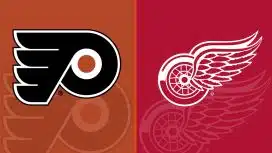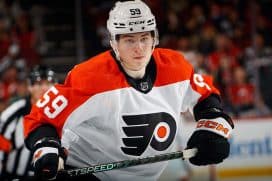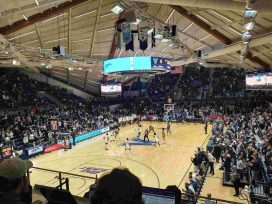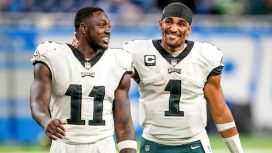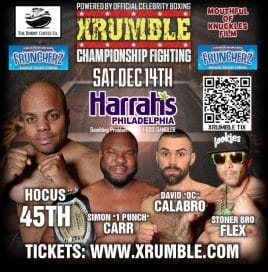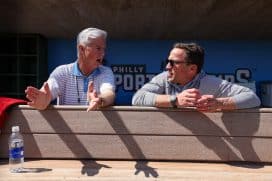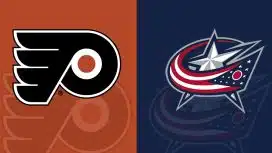Phillies
Aaron Nola’s 2.27 ERA through 14 starts puts him in historic company
By Tim Kelly, Sports Talk Philly editor
Philadelphia Phillies RHP Aaron Nola struck out 10 in 6.2 innings against the Colorado Rockies Tuesday night. The 25-year-old allowed just four hits and was charged with one earned run, allowing his ERA to lower to 2.27, which is tied with New York Yankees starter Luis Severino for the eighth lowest ERA in the majors. While Nola's 2.27 ERA through his first 14 starts puts him among the game's very best starters, it has another effect – it represents one of the greatest starts to a season by a Phillies starter ever.
Consider this: in 2010, his first season with the Philadelphia Phillies, the late Roy Halladay won the National League Cy Young Award. The following season, he was edged out by future Hall of Famer Clayton Kershaw in one of the tightest Cy Young races in recent memory. Halladay may have been more of a workhorse than Nola is, but in neither of those seasons did he have an ERA as low as Nola does through his first 14 starts in 2018.
In 2010, Halladay had a 2.36 ERA with an 8-5 record after 14 starts. Remember, he won his second Cy Young Award that season. In 2011, Halladay had a 9-3 record with a 2.39 ERA through his first 14 starts. Halladay finished that season with a 19-6 record, a career-low 2.35 ERA and a career-high 8.3 fWAR.
Related: Cliff Lee's Month of June 2011 Remains Unfathomable
Halladay is just the tip of the iceberg in terms of historically dominant Phillies starters who didn't have an ERA at 2.27 or lower through 14 starts in their best seasons in red pinstripes.
Cliff Lee finished third in National League Cy Young voting in 2011, behind Kershaw and Halladay. Though he would finish the season with a 2.40 ERA, 2.68 FIP and 6.8 fWAR, Lee had a 3.41 ERA through 14 starts in 2011. That was largely due to a relatively slow start in his return to Philadelphia, one that saw him post a 3.94 ERA through his first 12 starts. Still, Lee followed up a slow first two months with perhaps the greatest month in Phillies history in June 2011. In June of 2011, Lee went 5-0 with an 0.21 ERA, allowing just one run in 42 innings and tossing three complete game shutouts. Even after an incredible month of June, when he had made 16 starts on the season, Lee's ERA sat at 2.66, 39 points higher than what Nola is currently at.
Perhaps lost in the dominance of Halladay and Lee in 2011 was that Cole Hamels also had what most consider the finest season of his career. Hamels joined his two rotation mates on the National League All-Star team and finished fifth in National League Cy Young voting after posting a 2.79 ERA, a 3.05 FIP and a 4.9 fWAR, all of which were career highs. Hamels had a 9-2 record through his first 14 starts in 2011, but his ERA stood at 2.49, 22 points higher than where Nola is at after 14 starts.
Nola's incredible standing in terms of ERA after 14 games goes beyond just the 2011 rotation, which is considered the greatest in franchise history.
In 1997, Curt Schilling finished the season with a 2.97 ERA, a 2.62 FIP and an 8.2 fWAR. But a few early outliers left Schilling with a 2.99 ERA after 14 starts. A year later, in the midst of the Steroid Era, Schilling lasted eight of more innings in eight of his first 14 starts. He would finish the season with a 3.25 ERA, a 2.77 FIP and what, at the time, was a career-high 8.3 fWAR. But you guessed it, his ERA through his first 14 starts wasn't as low as Nola's is now, as it stood at 2.76.
Steve Carlton's 1972 season is considered by many to be the greatest individual season that a Phillie has ever had. Despite playing for a Phillies team that finished the season 59-97, Carlton went 27-10 with a 1.97 ERA and a 2.01 ERA. He posted an 11.1 fWAR, which is the highest fWAR that a Phillie has ever posted in an individual season. But Carlton's ERA was 2.83 after 14 starts, and it took him until his 26th start that season to get his ERA back to 2.27.
It's more than understood that what was asked of starting pitchers has changed over time. Nola has a 2.27 ERA over 91.0 innings in his first 14 starts of 2018. Halladay had 107 innings over the same period in 2010, and over 105 innings through 14 starts in 2011. Lee logged 94.3 innings through his first 14 starts in 2011. Hamels tossed 97.2 innings over the same span. Schilling had 96.4 innings through his first 14 starts in 1997, and 107.2 innings in 1998. Carlton, who would throw nearly 350 innings in the 1972 season, logged 111.1 innings through 14 starts. So like anything, it's difficult to make exact comparisons between elite performers who played in different eras.
Still, the numbers presented throughout the course of this article suggest that Nola is having one of the finest seasons that a Phillies starter has ever had. His 2.63 FIP and 3.04 xFIP lead you to think that he hasn't had unsustainable success because of great luck. Nola's 2.8 fWAR is currently third among National League starting pitchers, trailing only perennial Cy Young Award contenders Max Scherzer and Jacob deGrom. And as Baseball Reference noted, he became the first starter in Phillies franchise history to post multiple 10 strikeout, zero walk games at age 25 or younger Tuesday evening.
The 2014 first-round pick hasn't been 25 for 10 days, but he's putting together a campaign that's going to propel him to the All-Star Game in July. Once viewed as having a high floor but perhaps not as high of a ceiling as some arms taken in his draft class, Nola could very well finish in the top five in National League Cy Young voting in 2018. Nola won't even become arbitration eligible until 2019, but the fact that his first 14 starts have put him in the same breath as Halladay and Carlton lead you to think that a long-term extension for Nola may be something that Matt Klentak and the Phillies have to consider in the near future.
